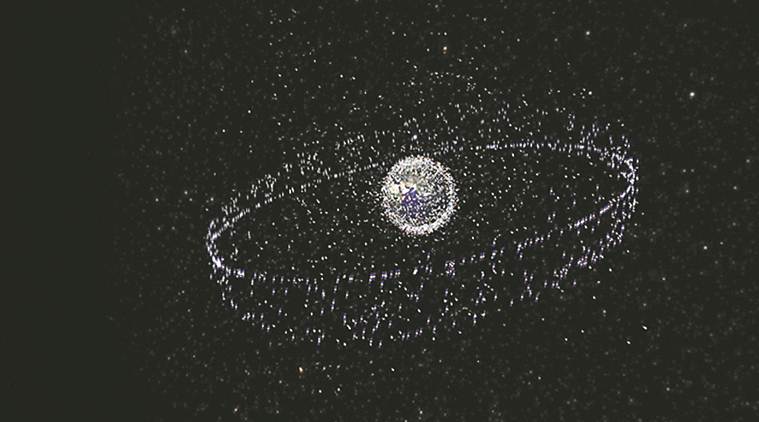Relevant for General Studies & Essay.
According to the European Space Agency, there are about 34,000 objects of size 10 cm or above in space, another 90,000 of objects of sizes between 1 and 10 cm, and a further 128 million of sizes between 1 mm and 10 mm.

- After the US government — and the rest of the world — had responded rather quietly to India’s first anti-satellite missile test last week, the head of US space agency NASA came up with the first major international criticism Monday. NASA administrator Jim Bridenstine said the debris created by the test had increased the risk to the International Space Station (ISS). While he acknowledged that this risk was comparatively small and short-lived, he added that it was a “terrible terrible thing” for countries to “create events that send debris” close enough to the International Space Station.
So, why exactly is NASA unhappy?
- On March 27, India demonstrated its capability for shooting down a satellite with a missile fired from the ground, becoming only the fourth country with such a capability. The satellite, which was one of India’s own, was literally left in pieces — thousands of them. On Monday, Bridenstine said NASA had identified at least 400 pieces from the wreck, and was tracking 60 that were larger than 10 cm in size. He said 24 of these 60 had got near the ISS and thus posed a potential threat of collision.
- The ISS is the world’s only permanent laboratory in space. It is massive, spanning a little larger than a football field, and weighing over 400 tonnes. Hanging about 400 km above Earth’s surface, the ISS carries extremely costly infrastructure, with facilities to host three to four astronauts at a time. It serves as a unique platform to carry out a variety of scientific experiments in space, especially those that require zero-gravity situations, and also for testing new space systems and technologies.
What threat could small pieces pose to such massive infrastructure?
- The size and weight of the pieces are secondary. What is crucial is that these pieces move at very great speeds. In the low earth orbit, where the targeted Indian satellite was located, objects typically move at almost 8 metres per second, or 28,000 kph, in order to stay in their orbits. At such speeds, even a tiny object of just about 100 grams would produce the same kind of impact on collision as a 30-kg stone travelling at about 100 kph. The debris from the destroyed Indian satellite would be typically moving at these speeds. A collision with any other satellite in space could render that satellite dysfunctional, if not destroy it.

But given the debris already in space, has the ISS not been at risk anyway?
- The ISS, or any other satellite for that matter, is constantly at risk from space debris. Such risk increases or decreases depending on the paths taken by the moving pieces of space debris. Specialised NASA agencies track all the significantly large pieces, over 23,000 of them, as does a similar facility at European Space Agency. These continuously evaluate the risk, and ground control stations take evasive action if necessary.
- The trajectory of the ISS is screened at least three times every day. If an object is assessed to have the potential to enter a space box of size 25 km × 25 km × 4 km (height) around the ISS, it is considered a potential threat. The probability of collision is computed and, if required, the ISS is navigated away from its normal trajectory. Such navigations are called Debris Avoidance Manoeuvres or DAMs; since 1999 the ISS has undergone 25 DAMs, the last time in 2015.
In that case, how does the debris from the Indian satellite present a special risk?
- It does not pose any special threat to ISS. The 24 additional pieces add to the risk profile of the ISS. Significantly, however, the NASA administrator said the risk to ISS had increased 44% “in the last 10 days”. Given that the Indian test was carried out only five days earlier, the statement appears to imply that the debris from the Indian satellite was not the only factor responsible for this increase in risk. Bridenstine also said that the probability of the ISS having to undertake a DAM because of the Indian satellite debris was “very low”.

NASA and European Space Agency have an elaborate network of radars and optical instruments across the globe to monitor and track the movement of space debris.
But didn’t India say it had taken care to prevent the problem of debris?
- India had said that since the test was carried out in low-earth orbit at just about 300 km from Earth’s surface, the debris created would decay and fall back on to the earth within weeks. Low-earth orbit at about 300 km has both atmosphere and gravity, though considerably weaker. Fragments of the Indian satellite are expected to lose their velocities due to the atmospheric drag and then fall towards Earth under gravity, and likely get burnt away due to air friction.
- However, immediately after a hit, it is not unexpected of some of the fragments to fly off in various directions. The satellite was in an orbit that was 283 km from Earth, while ISS is located at about 400 km. The difference between these orbital heights, however, does not alone reflect the distance between them, which is also a function of which points of their respective orbits they are in at a given time. In any case, the fragments from the Indian satellite were not expected to travel more than 50 km from the original trajectory after being hit. The NASA administrator has not said how close to the ISS the 24 pieces were located. So, it is not clear how big a risk these pose to the ISS.
What is the Indian assessment of the debris produced?
- ISRO (Indian Space Research Organisation) does not have the resources or the capability to track space debris. It depends on NASA for information on debris to adjust the flight paths of its launches and existing assets in space. NASA and European Space Agency have an elaborate network of radars and optical instruments across the globe to monitor and track the movement of space debris.
The US has itself carried out several anti-satellite tests. Didn’t those contribute to the debris?
- These were all carried out much before space debris became a serious concern for the major space-faring countries. In recent times, only China has carried out an anti-satellite test similar to India’s, when it downed its Fengyun-1C spacecraft in 2007. That test continues to be the source for the maximum amount of debris ever created in space. It resulted in more than 1.5 lakh large and small pieces, of which 3,428 are large enough to be tracked through radars. Bridenstine mentioned that while the debris from the Indian test was expected to dissipate soon, a lot of the debris from the Chinese test continues to be in orbit.
- The second biggest source of space debris was a rare collision between two spacecraft. In in February 2009, the inactive Russian satellite Kosmos 2251 collided with Iridium 33, a US company’s operational communications satellite. It remains the only instance of such a collision in low-earth orbit. There is no known case of a piece of debris colliding with and damaging or destroying a satellite.
How common are collisions in space?
- According to the European Space Agency, there are about 34,000 objects of size 10 cm or above in space, another 90,000 of objects of sizes between 1 and 10 cm, and a further 128 million of sizes between 1 mm and 10 mm. Yet, considering the vastness of space, it is not surprising that collisions, even between pieces of debris not moving in any fixed orbit, are extremely rare.

